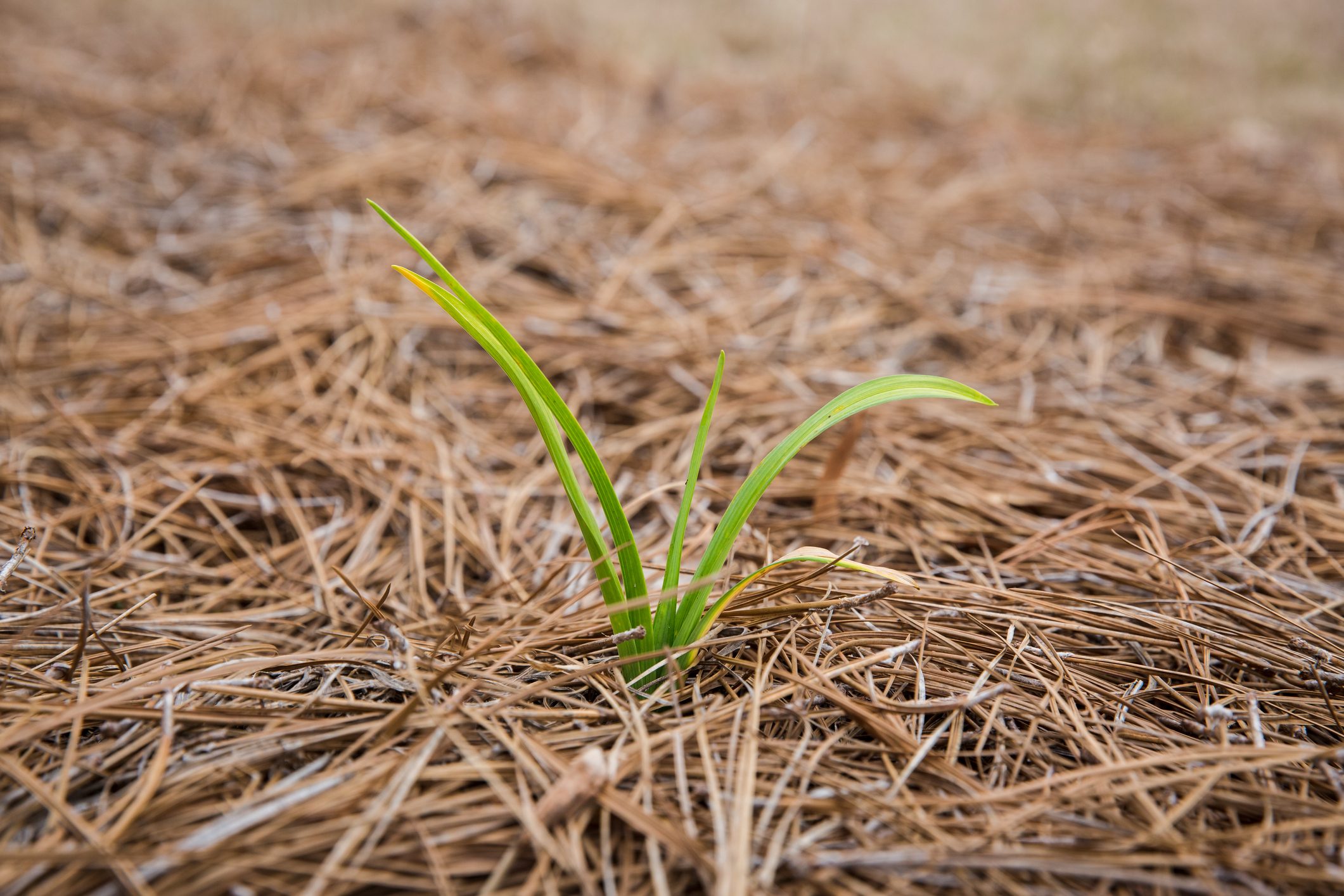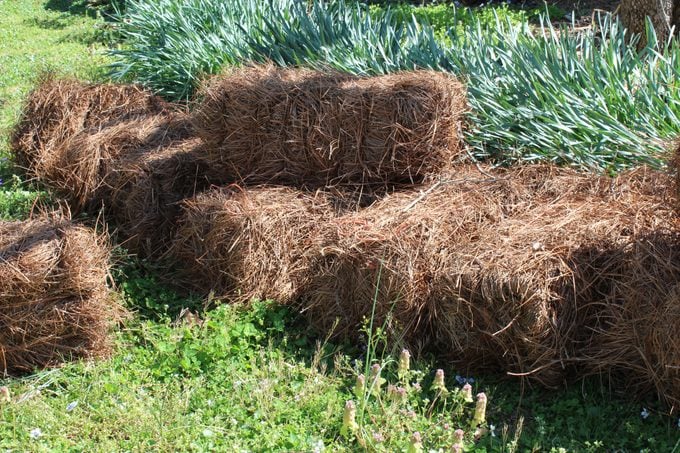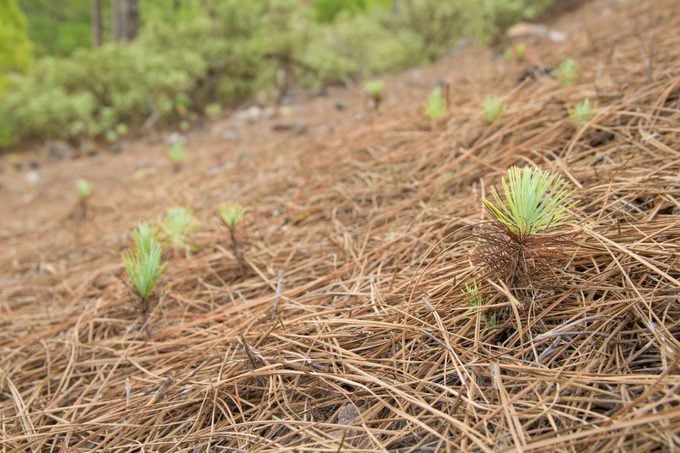This sustainable mulch is great for rustic, natural landscape design.
Our editors and experts handpick every product we feature. We may earn a commission from your purchases.Learn more.


This sustainable mulch is great for rustic, natural landscape design.
Our editors and experts handpick every product we feature. We may earn a commission from your purchases.Learn more.
If you’re looking for a low maintenance and long-lasting mulch option, pine needles might be just what you need. Pine needle mulch, also known as pine straw mulch, is less commonly used than other organic mulches. However, it’s growing in popularity thanks to its convenience and fluffy appearance. See what experts have to say about pine needle mulch.
On This Page
Pine straw is an organic mulch made from fallen pine needles, explains Mary Jane Duford, founder of the beginner gardening blog Home for the Harvest. Like any garden mulch, pine needles create a protective layer that insulates plants, keeps the ground moist, enriches the soil and blocks weed growth.
While pine straw and other mulches have similar uses, a few things set pine straw apart from wood or stone mulches. For one, pine straw often comes in bales instead of bags.

“Pine needles are very cost-effective and abundant,” says Codey Stout, head of operations for TreeTriage. “They are my favorite go-to mulch as a sustainable alternative.”
Store-bought pine straw tends to cost much less than wood mulch. A three-dollar bag of plain brown mulch from Lowe’s covers 12 square feet of ground at a two-inch depth, so roughly 25 cents per square foot. A $16 bag of pine needle mulch from Ace Hardware covers 100 square feet at a two-inch depth, roughly 16 cents per square foot.
Pine straw is also easy to DIY, since unlike wood mulch it doesn’t require a woodchipper. All you need is some yard waste — as in fallen pine needles. Duford says the best pine straw comes from long-needled species, such as Longleaf Pine (Pinus palustris) and Ponderosa Pine (Pinus ponderosa).
If you have long-needled pine trees, just collect some of the fallen needles. Neighbors with long-needled pine trees often are willing to share.
Pine straw is more lightweight than mulches such as stone or wood chips, Duford says, so boxes of pine needle mulch are much easier to ship. Once you get your pine needle mulch, its weight makes it easier to spread around the yard.
“Pine needle mulch typically lasts several years,” says Duford. Since it breaks down naturally, pine straw doesn’t need to be removed. It can, however, benefit from refreshing. Since it compacts over time, many people opt to fluff their pine needle mulch with a rake in the spring. You can top off with fresh mulch at the same time.
If you do decide to remove your old mulch, pine straw is much easier to rake up than wood or stone mulch. You can also compost pine straw. It’s easier to compost if you cut it with garden scissors or a mulcher before adding it to the pile.
While mulch does serve a purpose in the yard, its aesthetic value can’t be ignored. That’s why so many wood mulches come dyed red or brown. Some people like the fluffy, natural appearance of pine straw better than other mulches. If the wild look isn’t your style, a dyed wood mulch might be better.
You can spread pine straw anywhere you use other organic mulches. “Pine needle mulch is used both as a growing season surface mulch to keep weeds down and retain soil moisture, and also as a thick protective winter mulch over tender plants,” says Duford.

If you’ve had trouble keeping mulch somewhere before, Duford recommends trying pine straw. “Pine needle mulch is especially effective in areas where other mulches tend to slip, as the long needles nest together and interlock to create a mat,” he says. It’s like the springy floor in a pine forest.
Since it breaks down and adds nutrients to the soil, pine straw can also help plants that need a boost. “As an arborist, I use pine needle mulch to help sick trees,” Stout says. “Often the soil has lost its nutritional value.” It may take some time before you see a difference.
You should not use pine needle mulch in wildfire danger zones. “Small pines can easily catch fire and travel in a strong wind, carrying the fire with them,” Stout says. Instead, he recommends stone mulch for these areas.
There’s a common misconception that pine needle mulch will cause super acidic soil. Research shows that’s not the case.
According to Amy Jo Detweiler with the Oregon State University Extension Service, “Pine needles have a pH of 3.2 to 3.8 (neutral is 7.0) when they drop from a tree. If you were to take the freshly fallen needles (before the needles decompose) and turn them into the soil right away, you may see a slight drop in the soil pH, but the change would not be damaging to the plants.”
When used for mulching, pine needles break down and neutralize naturally. If you are concerned about the potential effect on soil pH, you can add a layer of compost beneath the pine straw.